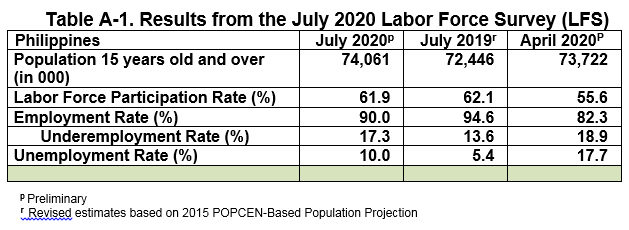
Highlights of the July 2020 Labor Force Survey
a. Unemployment rate in July 2020 was estimated at
b. Labor force participation rate (LFPR) in July 2020 was registered at
c. Employment rate picked-up at
d. On average, employed persons worked
e. Employed persons who reported with job but not at work was estimated at
f. Underemployment rate is down to
g. While most parts of the country eased the restrictions for community quarantine, five regions still reported double-digit unemployment rates. The highest unemployment rate estimate of
h. Labor force participation rate is lower among women at
i. Arts, entertainment, and recreation was the most affected sector in
j. Youth labor force participation rate (LFPR) improved in
(Sgd.) DENNIS S. MAPA, Ph.D.
Undersecretary
National Statistician and Civil Registrar General
Technical Notes
- Starting April 2005, the new unemployment definition was adopted per NSCB Resolution Number 15 dated October 20, 2004. As indicated in the said resolution, the unemployed include all persons who are
15 years and over as of their last birthday and are reported as: (1) without work and currently available for work and looking for work; or (2) without work and currently available for work but not looking for work due to the following reasons:
1. Tired/believed no work available
2. Awaiting results of previous job application
3. Temporary illness/disability
4. Bad weather
5. Waiting for rehire/job recall
- Starting April 2012 LFS, the codes for industry adopted the 2009 Philippine Standard Industrial Classification (PSIC). Prior to this, codes for industry used the
1994 PSIC. Further, question on vocational course was also introduced in theApril 2012 LFS questionnaire. In addition, the 2012 Philippine Standard Occupational Classification (PSOC) was adopted startingApril 2016. The1992 PSOC had been used prior to this round. - In April 2017 round, Computer Aided Personal Interviewing (CAPI) using Tablet was utilized in the LFS enumeration.
- In January 2019, the 2017 Philippine Standard Classification of Education (PSCED) has been adopted. The categories for highest grade completed were also revised considering the
K to 12 program in the education system. - Starting January 2020 LFS round, the population projections based on the 2015 Population Census (POPCEN 2015) has been adopted to generate the labor force statistics. For comparability, population projections based on the
POPCEN 2015 was likewise used in theJuly 2019 labor force statistics. - In April and July 2020 LFS round, ECQ/Lockdown/COVID-19 Pandemic was included in the reasons for working more than
48 hours, less than40 hours, and not looking for work. For the first time, a hybrid approach was used in data collection, a mixed mode of CAPI face-to-face interview, whenever possible, or a telephone interview. - Overseas Filipino Workers are not considered part of the labor force in the Philippines. Hence, in the LFS, data on economic characteristics of household members who are overseas workers are not collected. For the LFS reports, they are excluded in the estimation of the size of working population, that is, population aged
15 years and older, and in the estimation of the labor force. - The July 2020 LFS was conducted from
08 to 31 July 2020. The provision of minimum health protocols like masks, face shield, and alcohol were provided to all PSA officials and statistical researchers who did the survey.
